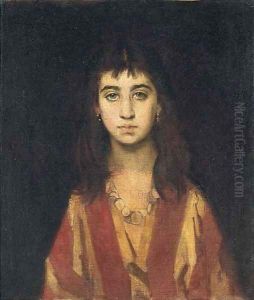Aleksei Alekseevich Harlamov Paintings
Aleksei Alekseevich Harlamov was a notable Russian painter known for his genre scenes and portraits, particularly of young peasant women. Born on October 24, 1840, in Saratov, Russia, Harlamov grew up during a period of significant social and cultural change in Russia, which was reflected in his artistic work.
Harlamov received his early education in art at the Moscow School of Painting, Sculpture and Architecture. He later studied at the Imperial Academy of Arts in Saint Petersburg, where he honed his skills under the tutelage of renowned artists of the time. His talent was recognized early on, and he was awarded several medals and scholarships, which allowed him to travel and study abroad.
The artist spent a considerable amount of time in Paris, which was the epicenter of the art world in the 19th century. There, he was influenced by the works of the French realists and classical painters. Harlamov's style, however, remained distinctively Russian, characterized by a warm palette, detailed textures, and a compassionate portrayal of his subjects. His paintings often depicted the simple beauty and dignity of Russian peasant women, and he was praised for his ability to convey their inner life and emotions. Harlamov's works were well-received not only in Russia but also across Europe, and his paintings were exhibited in numerous international exhibitions.
Despite the popularity of his work during his lifetime, Harlamov's legacy faded somewhat after his death in 1925. However, his paintings continued to be appreciated by collectors and art historians, and his contribution to Russian art has been reassessed over time. Today, Harlamov's works are considered valuable examples of 19th-century Russian painting, reflecting the social milieu and artistic trends of his era.
